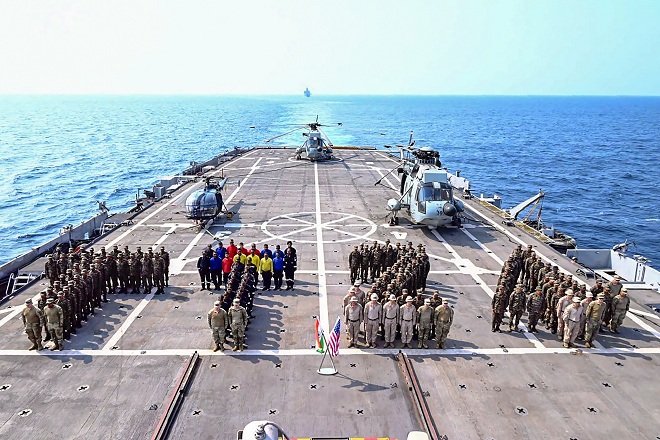
An internet imagery
BEIJING (PTI): China successfully launched an unmanned cargo spacecraft Tianzhou-3 on Monday to deliver supplies for its under-construction space station Tiangong, which is scheduled to be completed by next year.
The Long March-7 Y4 rocket, carrying Tianzhou-3, blasted off from the Wenchang Spacecraft Launch Site in the southern island province of Hainan, China Manned Space Agency (CMSA) said.
Tianzhou-3, which carried supplies for the upcoming six-month manned mission called Shenzhou-13, later successfully docked with the space station, the CMSA said.
The Tianzhou series are cargo spacecraft carrying material supplies to the space station which is to be ready by next year.
On September 18, the Tianzhou-2 cargo craft separated from the rear docking port of Tianhe and docked with its front docking port.
The CMSA said that the combination of Tianhe and Tianzhou-2 is in good condition, waiting for docking with the Tianzhou-3 cargo craft and the next manned mission Shenzhou-13 spaceship, the state-run Xinhua news agency reported.
On September 17, three Chinese astronauts who spent 90 days, the country's longest crewed mission, returned to Earth. The three spent three months building the station.
They spent 90 days at the Tianhe module on China's space station, some 380 kilometres above Earth.
Billed as the most prestigious and strategically important space project for China after the country's recent Mars and previous Moon missions, the low orbit space station would be the country's eye from the sky, providing a round the clock bird's-eye view for its astronauts on the rest of the world.
China previously sent the space station's Tianhe core cabin module on April 29, and a cargo spacecraft with supplies on May 29.
Once ready, China will be the only country to own a space station while the ageing International Space Station (ISS) is now a collaborative project of several countries.
It is expected to be a competitor to the ISS and perhaps may become a sole space station to remain in orbit once the ISS retires.
China's space station is also equipped with a robotic arm over which the US has raised concerns for its possible military applications.
The arm, which can be stretched to 15 metres, will also play a vital role in building the space station in orbit, Zhou Jianping, chief designer of China's manned space engineering project, had said.
Astronauts will team up with the robotic arm to make in-orbit space station construction and maintenance possible.
China in the past has launched several scavenger satellites fitted with robotic arms to gather and steer space debris so that it burns up in Earth's atmosphere. Once ready, the station is expected to be opened for China's close allies like Pakistan and other international space cooperation partners.
Ji Qiming, an assistant to the CMSA director, told the media on Wednesday that besides close cooperation with Russia, China is also having bilateral cooperation exchanges with countries including France, Italy, Pakistan and others focussing on space experiments in fundamental physics, space medicine and space autonomy on the space station.
Separately, China and Russia also unveiled a roadmap to build a lunar space station, official media reported. The station aims to develop research facilities on the surface of the moon, in orbit or both.
China plans to send several space missions including with astronauts to carry supplies and materials to complete the construction of the space station.
The space station will operate in low-Earth orbit at an altitude of 340-450 km above Earth's surface for more than 10 years.
The T-shape station has one core module at the centre and a lab capsule on each side.
Each of the modules will weigh over 20 tonnes, with the total mass of the station expected to weigh about 66 tonnes.
Chinese President Xi Jinping, who spoke to the three astronauts soon after they entered the space station in June, termed the project an "important milestone" in the country's ambitious space exploration programme.
"The construction of the space station is a milestone in China's space industry, which will make pioneering contributions to the peaceful use of space by humanity," Xi had said.
China will carry out two more space launches for the building of the space station this year - the Tianzhou-3 cargo spacecraft via a Long March-7 carrier rocket from Wenchang spaceport in Hainan and another manned flight on a Shenzhou-13 spacecraft via a Long March-2F rocket from Jiuquan centre, the Global Times newspaper reported.
Following the Tianzhou-3 mission, the Shenzhou-13 manned spacecraft is expected to send another crew of three taikonauts to China's space station complex. They will live and work in orbit for an even longer stay of six months, it said.
 Previous Article
Previous Article Next Article
Next Article













The Indian Air Force, in its flight trials evaluation report submitted before the Defence Ministry l..
view articleAn insight into the Medium Multi-Role Combat Aircraft competition...
view articleSky enthusiasts can now spot the International Space Station (ISS) commanded by Indian-American astr..
view article